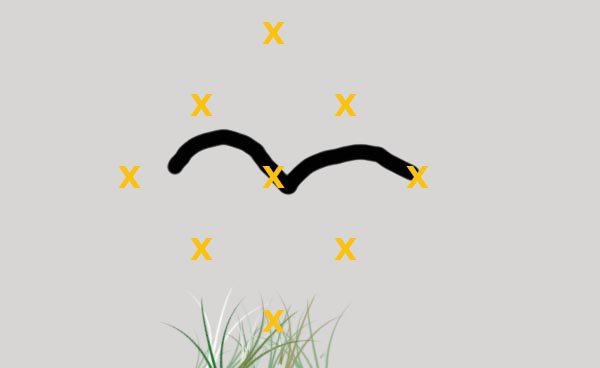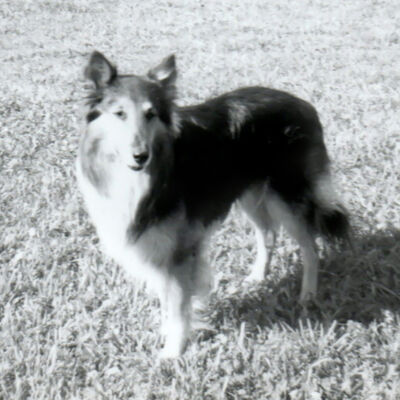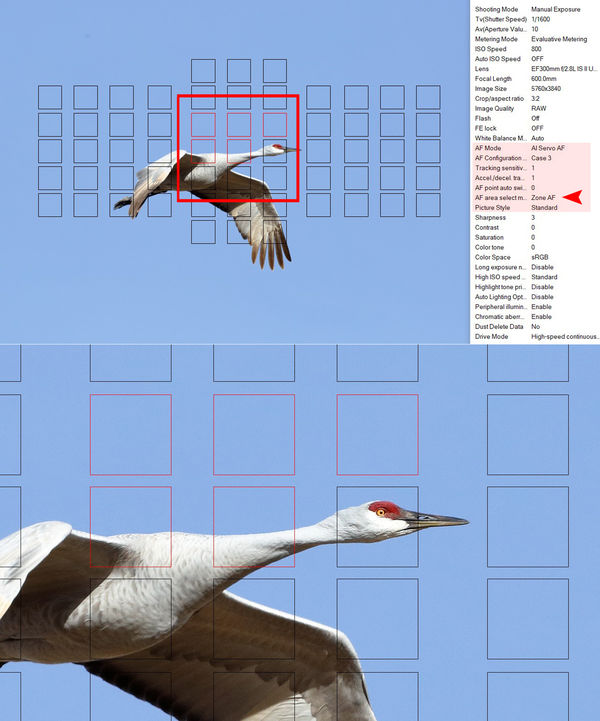Question about multi-point focus
Aug 24, 2020 10:30:51 #
Hopefully I can explain in words what my question is. When using multi-focus setting, and you see the grid showing many focus points, when you take the picture, will all of those points be in focus or is it just one of the many? Let me give a scenario to help explain my question. Let say I am taking a bird in flight shot and I point the camera so the grid is over the bird. Will all the points be in focus or just one that the camera selects. Hopefully this makes sense, but I totally understand if it doesn't. Thanks for your attempts to explain this.
Aug 24, 2020 10:37:04 #
The camera will use only those AF points that cover something the camera thinks is suppose to be in focus. Take your example of a BIF and a 9-point square aka Zone. Assume you're panning with a large bird, say a goose, flying against a solid blue sky. Only those AF points within the zone that cover the bird will be used.
Aug 24, 2020 11:01:19 #
Ysarex
Loc: St. Louis
boomboom wrote:
Hopefully I can explain in words what my question ... (show quote)
The question makes sense. The answer is that one point will focus. You're making the grid active so that the camera is searching for focus with all the active points. When it locks one of them that's the one you get.
Camera's (lenses) focus on a single flat plane X distance from the camera, period. Your camera is most likely equipped with a PDAF (phase detect auto focus) system. There is a natural tendency in PDAF systems to find focus on whatever is closet to you if the system is given multiple focus points to select from. In other words the camera will most often lock on the active point that is over whatever in the scene is closest to you.
Forgive my drawing ability but look at the illustration below. You have a large bird of prey flying over the water toward you. It is 30 yards away the yellow Xs represent the focus grid. You'd like to think the bird will be in focus but those marsh reeds that show in the frame that are 6 feet in front of you will be your focus point.

Aug 24, 2020 11:13:56 #
boomboom wrote:
Hopefully I can explain in words what my question ... (show quote)
I think the camera will look at the bird, and focus on the average of all the points in multi-focus modes. So none of the points are in focus or all of them are in the best sort of focus your camera can manage based on points being used. You probably want maximum depth of field for this type of shot, but I'm just guessing.
If you took a picture of a large stationary bird, with shallow depth of field, and spot focused on the eye, then the eye, and everything at that exact distance would be in focus, everything not at that exact distance would not be in focus. If you change focus mode to say many points of focus, then the camera would try to average all the points and nothing would really be in focus, but would hopefully be close enough for government work:-)
I'm no expert though, so I could easily be wrong...
Aug 24, 2020 11:34:45 #
Here's a real example, using the 9-point zone on an EOS 5DIII, other brands / models have 9- or 12-point zones that operate similar. I had the birds passing at moderate speeds and roughly similar distances, alone and in small groups heading into the sun toward a corn field just behind my position. I could not keep a single point nor expanded single point (5-points) on the birds while panning. The zone proved the best option.
Aug 24, 2020 11:35:14 #
That's why I use spot focus and BBF. I choose, not the camera
Aug 24, 2020 13:15:10 #
Test with a purposely arranged scene. Cameras differ quite a bit.
Example of one of my results:
On half pressing the shutter, a neatly arranged group of targeting marks lights up, showing where total AF coverage is.
At the moment of exposure an odd group of targeting marks remains lit. All other points extinguish themselves.
On inspection, it’s clear that the three oddly arranged marks represented three different items in the test scene that all shared the one plane of proper focus. There’s no averaging. Subject detail or a hard edge actually intersects the unique plane of focus at those three points.
Example of one of my results:
On half pressing the shutter, a neatly arranged group of targeting marks lights up, showing where total AF coverage is.
At the moment of exposure an odd group of targeting marks remains lit. All other points extinguish themselves.
On inspection, it’s clear that the three oddly arranged marks represented three different items in the test scene that all shared the one plane of proper focus. There’s no averaging. Subject detail or a hard edge actually intersects the unique plane of focus at those three points.
Aug 24, 2020 13:15:36 #
Ysarex wrote:
The question makes sense. The answer is that one p... (show quote)
Good answer. I think one main takeaway is that there is only one plane of sharpest focus and it is parallel to the sensor. So a big bird flying left to right might have the wing tips on the plane of sharpest focus or the eyes on the plane of sharpest focus, but not both, unless it is angled such that the wing tips and the eyes are both at the same distance parallel to the sensor.
Aug 24, 2020 13:46:34 #
CHG_CANON wrote:
The camera will use only those AF points that cover something the camera thinks is suppose to be in focus. Take your example of a BIF and a 9-point square aka Zone. Assume you're panning with a large bird, say a goose, flying against a solid blue sky. Only those AF points within the zone that cover the bird will be used.
This is true, but also the part of the animal (bird in this case) that is the closest to the camera, is the point that will be most in focus. So if you were taking pictures of a Pelican and used multiple focus points, if the tip of the wing were on one of the focus points, it will be in focus and the eye, or head of the bird might be soft. This is the case mostly when using a long lens and when you have your aperture set wide open. In essence this is a DOF problem (depth of field). For small subjects this most likely won't be a problem.
Aug 25, 2020 06:19:05 #
CHG_CANON wrote:
Here's a real example, using the 9-point zone on an EOS 5DIII, other brands / models have 9- or 12-point zones that operate similar. I had the birds passing at moderate speeds and roughly similar distances, alone and in small groups heading into the sun toward a corn field just behind my position. I could not keep a single point nor expanded single point (5-points) on the birds while panning. The zone proved the best option.
I think you put that to bed. Tack sharp picture
Aug 25, 2020 06:32:59 #
tcthome
Loc: NJ
https://www.youtube.com/watch?v=TesyJSg9N9I
https://www.youtube.com/watch?v=69jcmNbqGrU
https://www.youtube.com/watch?v=R9YBeNBoKVw
https://www.youtube.com/watch?v=69jcmNbqGrU
https://www.youtube.com/watch?v=R9YBeNBoKVw
Aug 25, 2020 08:38:05 #
In most cases, according to the manuals, the camera will focus on the nearest object. That's why I use a single center point.
Aug 25, 2020 08:52:21 #
CHG CANON
I always enjoy reading your response to others questions. You rare spot on and really know your stuff. Thanks for very accurate and informative information.
I always enjoy reading your response to others questions. You rare spot on and really know your stuff. Thanks for very accurate and informative information.
Aug 25, 2020 11:13:42 #
boberic wrote:
That's why I use spot focus and BBF. I choose, not the camera
You clearly don’t shoot BIF.
Aug 25, 2020 12:21:03 #
CHG_CANON wrote:
The camera will use only those AF points that cover something the camera thinks is suppose to be in focus. Take your example of a BIF and a 9-point square aka Zone. Assume you're panning with a large bird, say a goose, flying against a solid blue sky. Only those AF points within the zone that cover the bird will be used.
Then if you have the time to focus manually, wouldn't it be better so it is your choice of what it is and isn't?
If you want to reply, then register here. Registration is free and your account is created instantly, so you can post right away.







